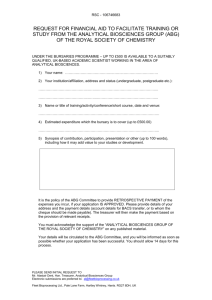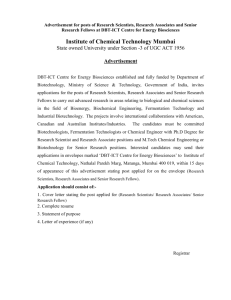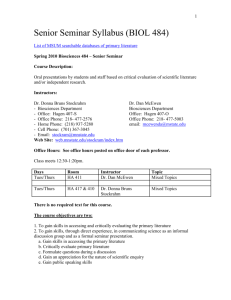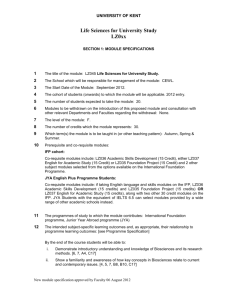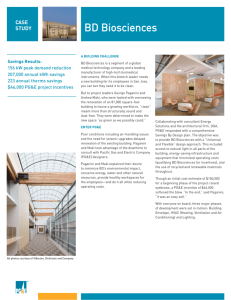BIOL10004-20-2015-gs-CellsTissuesOrgans
advertisement
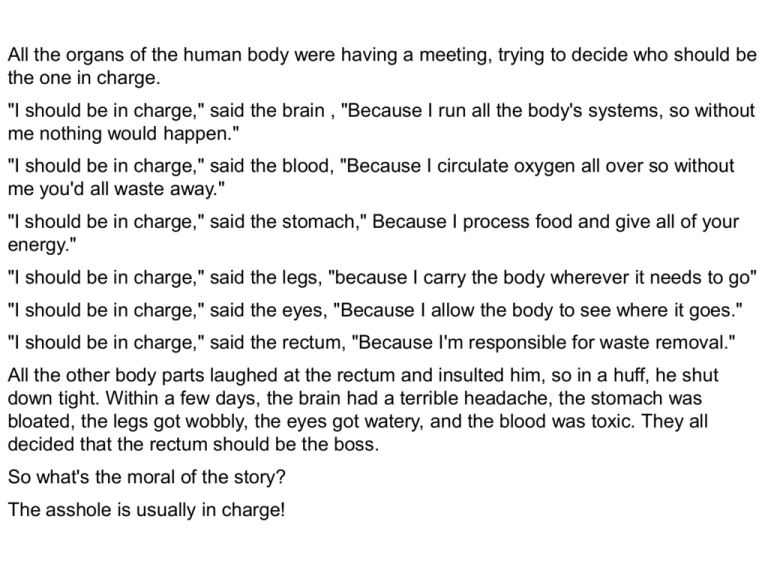
All the organs of the human body were having a meeting, trying to decide who should be the one in charge. "I should be in charge," said the brain , "Because I run all the body's systems, so without me nothing would happen." "I should be in charge," said the blood, "Because I circulate oxygen all over so without me you'd all waste away." "I should be in charge," said the stomach," Because I process food and give all of your energy." "I should be in charge," said the legs, "because I carry the body wherever it needs to go" "I should be in charge," said the eyes, "Because I allow the body to see where it goes." "I should be in charge," said the rectum, "Because I'm responsible for waste removal." All the other body parts laughed at the rectum and insulted him, so in a huff, he shut down tight. Within a few days, the brain had a terrible headache, the stomach was bloated, the legs got wobbly, the eyes got watery, and the blood was toxic. They all decided that the rectum should be the boss. So what's the moral of the story? The asshole is usually in charge! Copyright Notice Figures and images indicated by KLES are taken from the subject textbook R B Knox, P Y Ladiges, B K Evans and R Saint, Biology, An Australian Focus 4th Ed, McGraw-Hill, 2009, with permission of the publisher. Diagrams and images without that designation are © Geoff Shaw, or are from public domain BioSciences sources as indicated. Strategies for Learning • Revise early, Revise often. Number of students downloading L19 notes from LMS (by 24/4, 06:30 AM) Total students who have accessed at least one form of notes Students who had NOT accessed any notes from LMS <700 >1200 http://services.unimelb.edu.au/academicskills/undergrads/ top_resources BioSciences … continued from lecture 19 • Diverse gas exchange surfaces • Exchange rate area x pressure / distance (Fick’s Law) • Structure and function of respiratory structures – large surface area; rich blood supply; counter current flows; surfactant • Roles of convection and diffusion for gas exchange • Mechanisms of breathing and significance of dead space BioSciences Transport of oxygen 1. O2 dissolves in water (or blood plasma) 2. O2 combines reversibly with haemoglobin (Hb) 3. In 100 mL of oxygenated human blood, there is about 0.3 mL dissolved O2 and 20 mL O2 bound to Hb (40 mL in whale). BioSciences Iron-based respiratory pigments The oxygen-binding unit is haeme - based on Fe++. Oxygen binding is not an oxidation. Colour change BioSciences Haemoglobin • In vertebrate haemoglobin, 4 globins (2 alpha, 2 beta) form a tetramer, MW ca 68,000. – (Earthworm haemoglobin has MW ca 1,000,000.) • Binds and transports O2 - reversible • binds carbon monoxide http://en.wikipedia.org/wiki/Hemoglobin Oxygen transport in the blood • The amount of oxygen carried by blood is largely determined by the oxygen dissociation curve for haemoglobin, and by the local partial pressure of oxygen (PO2). 98% 100 100% The right-ward shift of the curve at low pH is called the Bohr effect. % saturation of HHb with O2 Arterial blood 75 50 Venous blood - high [CO2] & more acidic, - low [O2], 25 (tissue) (alveoli) (air) 0 40 BioSciences Note 1 Torr = 1 mm Hg 120 160 Blood PO2 (Torr) 160 PO2 (Torr) 120 80 40 0 0 2000 4000 6000 8000 10000 altitude (m) BioSciences Control of heart rate, blood pressure, and breathing vasomotor and respiratory centres in brainstem • baroreceptors (pressure) – great veins – aortic arch – carotid body • chemoreceptors (chemicals) • feed into vasomotor centre in brain stem - regulation of – – – – respiration heart rate; cardiac output blood pressure vascular tone (constriction of blood vessel walls) Heart Lungs BioSciences phrenic and thoracic nerves to diaphragm and intercostal muscles Brain – carotid body : O2 – aortic body: CO2 and pH Circulatory control and exercise EXERCISE of skeletal muscle incr. local metabolites decr O2, incr CO2 increased gas exchange in lungs Chemoreceptors: - carotid bodies - aortic bodies increased rate and strength of heartbeat baroreceptors in carotid and aortic bodies BioSciences vasoconstriction of some ateries increased blood to muscles local dilation blood vessels Awareness in higher centres of brain vasodilation of arteries to muscle Adapted from KLES5 fig 24.18 What drives ventilation? % CO2 in inhaled air breathing rate (L/min) 1 2 3 4 5 6 7 8 9 10 a small amount of CO2 in inhaled air stimulates a large increase in breathing rate 80 •Note - experiments with rebreathing air. 60 40 a small amount of O2 in inhaled air has little effect on breathing rate 20 18 16 14 12 10 8 6 4 % O2 in inhaled air BioSciences •Air-breathing tetrapods like us are very sensitive to CO2. 2 0 •Note - danger of hyperventilation before unassisted diving. •Chemoreceptors (CO2/pH, O2) in carotid and aortic bodies and (CO2/pH) in medulla of brainstem Cells, Tissues and Organs Professor Geoff Shaw School of BioSciences g.shaw@unimelb.edu.au Refs (list also includes some material covered in Lec 21): KLES5: Chap 7 esp. Tables 7.1-7.3 on pp 157-159, pp 163-174, Chap 28: pp 680-685 KLES4: Chap 7: esp. Tables 7.1-3, pp 153-163, Chap 27:636-640 Resources on LMS Examples of cells, tissues, organs, and their function and control mechanisms in Lectures 18,19,21,22,23 (and others) BioSciences Our bodies are made up of …. • organ systems – skeleton – muscles – nervous system – digestive system – circulatory system – respiratory system – ….. and lots lots more BioSciences And organs are made up of cells and tissues • Many different sorts – connective tissue – muscle – epithelium – glandular – neural – …. and so on… BioSciences Examples of tissues/cells mouse uterus blood muscle connective tissue epithelium BioSciences Coordination • at the inter-cellular level – example – NO and vascular control • at the tissue/organ level – – eg signalling in the heart – coordinated contraction… • At the whole organism level – – eg cardiovascular coordination – endocrine reproduction BioSciences How do cells communicate? • local – cell-cell contacts – chemical signals • distance – neural – endocrine BioSciences fast slower Homeostasis • from the Greek – homoios same – stasis standing still • a tendency to maintain a constant internal environment – also spelled Homoeostasis BioSciences Body Temperature Balance between heat generation and heat loss HEAT generation “Cold Blooded” animal increase heat loss or decrease heat production cooler decrease heat loss or increase heat production hotter “Warm Blooded” animal Balance: heat loss = heat made const Temp BioSciences lizard sunning itself on a rock… BioSciences Why do we maintain homeostasis? waste energy risk of predation etc etc BioSciences Why do we maintain homeostasis? waste energy risk of predation etc etc BioSciences metabolic efficiency less dependent on environment etc etc Control Mechanisms SET POINT INTEGRATORY SYSTEM SENSOR BioSciences RESPONSE (EFFECTOR) SYSTEM NEGATIVE FEEDBACK • Responses cause changes that tend to return to desired set-point sweating panting vasodilation Goosebumps (pilo-erection) shivering vasoconstriction seek shade/cool movement remove clothes warm clothes resting seek warm place BioSciences POSITIVE FEEDBACK • When responses increase the change from the set point – eg severely hypothermic person may undress… – LH surge in female reproductive cycle (discussed in a later lecture) – Birth (later in this lecture) BioSciences Homeostasis: body temperature • costs: – metabolic energy needed to stay warm in too cool environment – water loss for cooling (sweat, panting) in too warm environment BioSciences Homeostasis: body temperature • benefits: – cellular enzymes optimised for one temperature, ↑ efficiency – can remain active in cold • more time to forage • less risk of predation – able to use wider range of environments BioSciences Homeostasis: blood gas Breathing and exercise: breathing circulation exercise air O2 blood O2 input output? BioSciences tissues O2 + sugar CO2 Homeostasis: blood gas • hold your breath – what happens – ↓ blood O2 and ↑ CO2 – CO2 ↔ carbonic acid pH sensor … urge to breathe too great. Deep breaths taken… Blood CO2 excess CO2 lost quickly hold breath Time BioSciences “overshoot” and responses to correct (reduced breathing) Hyperventilation • rapid deep breathing –loss of CO2 increased pH light headed, dizzy, tingling … If ↑ CO2 = ↓ O2 dilation of arteries to brain then ↓ CO2 = ↑ O2 contraction of arteries to brain BioSciences Homeostasis: blood glucose Food metabolism storage absorption gycogenolysis storage absorption transport glucose + glucose +… glycogen glycogen glucose +… release glucose+O2 CO2+H2O transport metabolism BioSciences transport Homeostasis: blood glucose BioSciences eat chocolate eat chocolate blood glucose If no “feedback” regulation…. (…diabetes…) time 4.5 mmol/L Insulin and glucagon • peptide hormones • made by islet cells in pancreas blood glucose glucose glucose glucose glucose glucose glucose glucose Liver cells glucose glucose glucose BioSciences INSULIN GLYCOGEN GLUCAGON Homeostasis: blood glucose eat chocolate bar BioSciences high glucoseinsulin insulinglucose stored in glycogen eat chocolate bar blood glucose With “feedback” regulation…. (normal) low glucoseglucagon glucagonglucose released from glycogen time 4.5 mmol/L Multiple regulatory mechanism… • endocrine: – – – – insulin glucagon adrenaline cortisol, … • behavioural – hunger eating – satiety fasting – activities • burn off sugar • lethargy, to conserve sugar • etc etc etc… BioSciences Birth, an example of a non-homeostatic processes oxytocin release Pituitary gland neural reflex Ferguson Reflex contractions stretch cervix BioSciences uterine contractions What do I expect you to learn from this lecture? • Levels of organization within an organism – cells, tissues and organs – communication between cells / tissues/ organs – endocrine and neural control • What is homeostasis? • What are some costs and benefits of homeostasis? • How do feedback systems work ? (sensors integrators response systems) • Negative and positive feedback • Examples of some homeostatic systems – body temperature – blood gases – blood glucose
